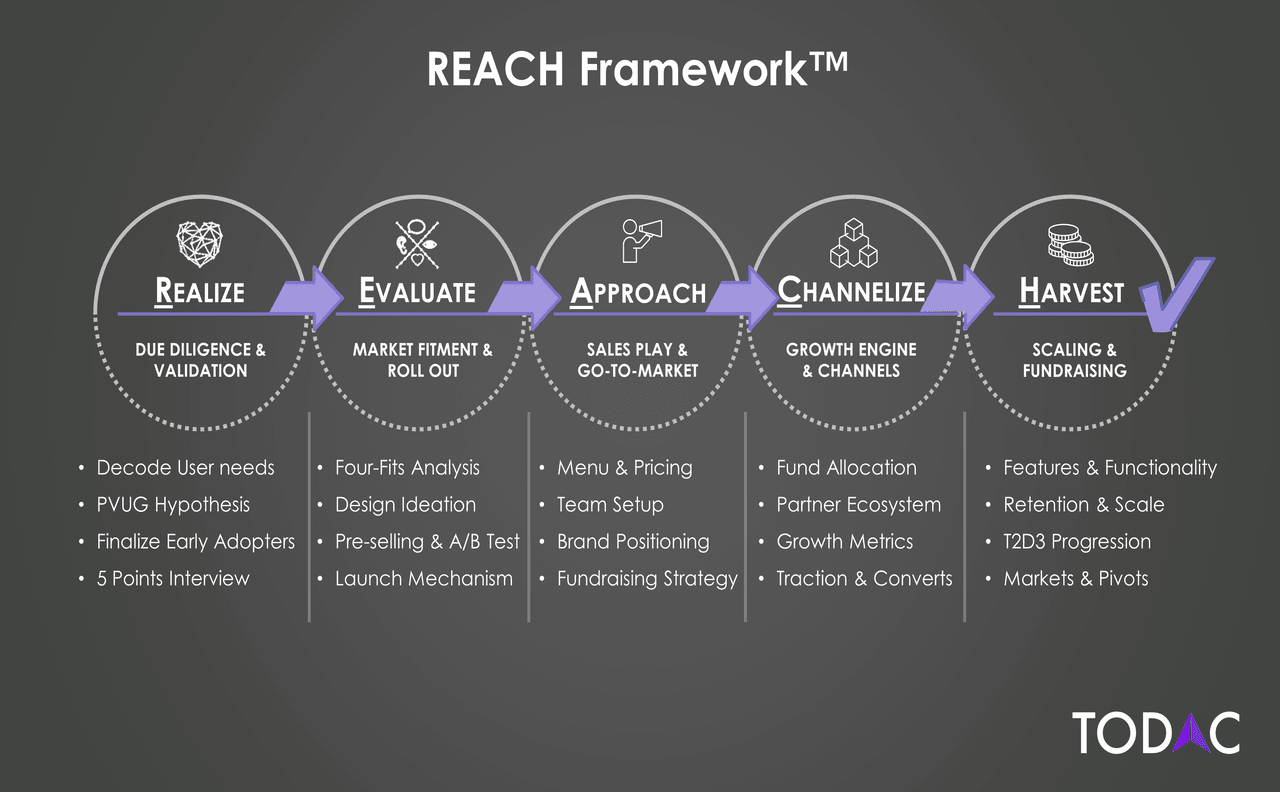Talk to any new business owner and they all have one common confusion - Do I invest my time and energy on improving my product? Or on selling what I already have? They are often caught in the loop between bettering their solution technically and devoting their time to marketing and sales. What if there was an easy guide to navigating the market journey?
We introduce the REACH Framework - A step-by-step guideline to make your technical offering market ready for enterprises.
Introducing REACH
REACH stands for Realize - Evaluate - Approach - Channelize - Harvest. It is a 5-step catalyst for the “How” stage of the business cycle. REACH is derived from an in-depth research of how products perform in the market, and is designed to help founders productively focus their efforts on solving customer problems.
At its core, the REACH Framework is a set of methods and processes crafted together for a product to attain the four-fits across Market, Solution, Model, and Channel. By using the right mix of enablers for product scaling and market growth, the REACH FRAMEWORK helps founders realise value from their business within determined timeframes.
The REACH Framework
REACH is based on a 5-step methodology.
- Realize : The Realize step aims to decode needs and expectations from the user through due diligence and validation. It adopts the PVUG hypothesis to go from product to business value. A main focus is to identify the selected few who can serve as early adopters for the product, ensuring the minimum viable product can get enough traction and validation, and scale up to attract a broader customer base. The phase involves identifying and working closely with thought leaders and influencers from the target customer segment.
- Evaluate : This is the stage where the “Four Fits” are analysed and the product/market plan is iteratively worked upon to achieve the right market fitment and corresponding product roll out. Design ideation, pre-selling, A/B testing, launch mechanism - the Evaluate stage handholds businesses to achieve fruition, within their constraints.
- Approach : This is the segment that deals with taking the product to the actual customer - in other words, Sales play and go-to-market. What does the GTM preparation entail?
- GTM begins with identifying the feature offerings according to sects, and setting up the corresponding pricing.
- Setting up a team that can work in tandem to achieve business goals. The debate Brand Positioning debate that decides how your customer will see your product, and whether you can keep up with the image being portrayed
- Lastly, strategising the approach to fundraising, from creating the right pitch to providing a saluting that VCs will want to support.
- Channelize : The Channelize phase is all about growth and using the right channels to reach potential customers. It involves a meticulous scrutiny of funds to finalise the marketing methods to adopt, becoming one with the partner ecosystem, identifying relevant growth metrics and monitoring them stringently, and working to convert the efforts into value realisation.
- Harvest : Finally, the Harvest stage helps you take the next steps to scaling and fundraising by focusing on product features and functionality. While the primary aim is to scale the product, it is as important to ensure existing customers are satisfied and not lost in the process. Now that the product base is set, the focus here is to multiply revenue by making the product better.
Scaled Business Planning through the REACH program

The REACH framework works to space out the product journey from idea to value realisation. With concentrated efforts for growth over a period of 3 to 9 months, founders will start to go from the ‘Product introduction’ in the early stage to the ‘differentiated market’ phase in the seed stage. Thus, founders now have a tried and tested process to pilot them through their product journey, being able to focus on the technical growth, while product growth planning is taken care of.
